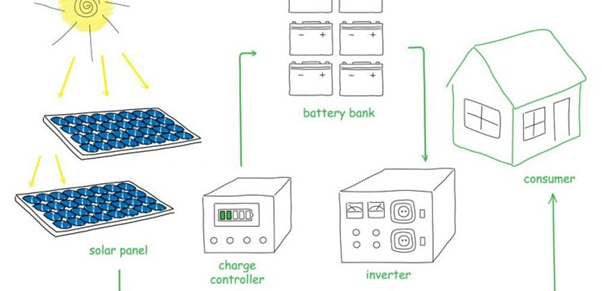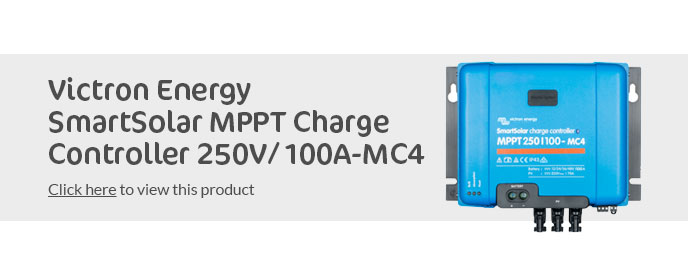A charge controller is a device controlling the charge of batteries within a PV system by properly managing the current and the battery voltage. Charge controllers protect the battery and ensure the solar system’s efficient operation which in turn delivers a system that will last for years to come.

Charge Controller Functions
• Restricts charging voltage and protects the battery from overcharging.
• Protects the battery from unwanted or deep discharging; it disconnects automatically the battery loads as the voltage falls below the discharge value.
• Offers information about the charge of the battery.
• At night, the PV modules are used to prevent reverse current.
Different Types of Solar Charge Controllers
Selecting a solar charger controller means knowing the two different types.
The generally cheaper, but less efficient Pulse Width Modulation (PWM) charge controllers and the highly efficient Maximum Power Point Tracking (MPPT) charge controllers. Both technologies are used widely, protect the battery, and typically have a lifespan of around 15 years, although that may vary from product to product.
Pulse Width Modulation Charge Controllers: Best for those with small-scale systems
PWM controllers are the original and simpler charge controllers. They regulate the flow of energy to a battery by reducing the current gradually which is the process known as ‘pulse width modulation’. In contrast to providing a steady output, pulse width modulation charge controllers provide a series of short charging pulses to the battery.
When batteries are full, the PWM will keep supplying a minimal amount of power to keep the batteries full. This two-stage regulating is the perfect fit for a system that may experience little energy use. Because the Solar panel and the batteries must have matching voltages, PWM controllers are best suited for small scale applications.
A prime example of a PWM charge controller is the BlueSolar PWM-Pro series from Victron.

It’s diverse feature set includes:
• Lighting control function, fully programmable.
• Three-stage battery charging (bulk, absorption, float), fully programmable.
• Integrated battery monitor function (Remote Panel needed to display state of charge).
• Load output with low voltage disconnect and manual control (default setting).
• Optional external temperature sensor.
• Load output protected against overload and short circuit.
• Protected against reverse polarity connection of the solar panels and/or battery.
• Day/night timing options: see manual Remote Panel for details.
Maximum Power Point Tracking charge controllers are efficient at using the full power of your solar panels to charge your batteries. With MPPT controllers, the current is drawn out of the panel at the maximum power voltage, but they also limit their output to ensure batteries don’t get overcharged. MPPT charge controllers will monitor and adjust their input to regulate the current from your solar system. The overall power output will increase as a result and you can expect efficiency ratings of 90% or higher.
For example, if it becomes cloudy, your MPPT charge controller will decrease the amount of current drawn to maintain a desirable voltage at the output of the panel. When it becomes sunny again, the MPPT controller will allow more current from the solar panel once again.
A prime example of a Studer MPPT charge controller is the Variostring VS-120.

Its accomplished feature set includes:
• Reduces Balance of System costs (eliminates expensive wiring for parallel strings, saving wires, connectors, junction boxes, fuses, space, time, etc.)
• Safety, reinforced isolation between the PV generator and battery and between the two PV inputs of the VS-120. This allows for independent earthing of the battery and/or solar modules
• High rating for efficiency in isolated converter with >98 % conversion efficiency
• 7kW per unit and up to 15 units in parallel: 105kW
• 4 step charger fully programmable for longer battery life
• 9 LEDs to monitor status and current
• Full display, configuration and data acquisition with RCC-02/03 and/or via the internet with the Xcom LAN/Xcom-GSM or via SMS with Xcom-SMS
Combine with a range of accessories:
• Display, programming and data logging remote control (RCC-02/-03)
• Communication sets (Xcom-LAN/Xcom-GSM)
• Communication module (Xcom-232i/XcomCAN)
• Battery temperature sensor (BTS-01)
• Battery Status Processor (BSP)
• Communication with lithium battery BMS (Xcom-CAN)
• 2 additional auxiliary contacts (ARM-02)
Another popular MPPT range of charge controllers is Victron’s SmartSolar range.

PV terminal options include the TR model, which is one positive and one negative screw terminal. And the MC4 model, which has 3 pairs of paralleled MC4 connectors.
Feature highlights common to all models:
• Ultra-fast Maximum Power Point Tracking (MPPT)
• Advanced Maximum Power Point Detection in case of partial shading conditions.
• Outstanding conversion efficiency
• Natural convection cooling
• Automatic battery voltage recognition
• Flexible charge algorithm
• Over temperature protection and power derating when temperature is high
Sizing options:
• Suitable for a variety of battery voltages. Most models connect to 12, 24, and 48V batteries, some only connect to 12 and 24V batteries, or only to 48V batteries
• Charge currents rating from 10A all the way up to 100A
• Maximum PV array Voc voltages ranging from 75V up to 250V
• Multiple chargers can be used in parallel, for large systems we recommend to use the models with a VE.Can communication port
Remote Monitoring & Control:
• Built-in bluetooth to connect with your smartphone or other device via VictronConnect
• Victron Remote Management Portal (VRM) provides access to the full power of your MPPT, anytime, anywhere; both services are free to use
• For remote installations - even when there is no internet connection or phone signal nearby - you may be able to monitor your MPPT by bluetooth-pairing with a LoRaWAN (long-range wide area network) device, available optionally
Optional SmartSolar Control Display
By adding the SmartSolar Control Display you will be able to check the status of your Charger and battery-storage at a glance. Simply plug it into the face of your MPPT charger to provide you with real-time monitoring and set-up capabilities.
At CCL we stock only the highest quality products and are proud to offer both Victron and Studer for both PWM and MPPT options when choosing a charge controller.
Call CCL Components today to find out more and which charge controller is the right one for you.
T: +44 (0) 1355 599 990
E: sales@blog.cclcomponents.com

